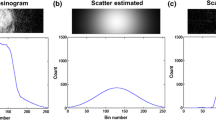Abstract
The physical performances of two current state-of-the-art scanners dedicated to functional imaging of the brain, one a single-photon emission tomography (SPET) scanner and the other a positron emission tomography (PET) scanner, have been compared under identical conditions. The aim of the study was to compare the capabilities of the devices under conditions resembling the routine clinical environment, as well as to consider other issues such as radiation burden for some common investigations. Both systems have slightly less than 11-cm axial fields of view. The PET system can be operated in a septa-less (3D) mode as well as conventionally with septa (2D). The spatial resolution of both devices was less than 8 mm in all dimensions in scattering media. On average, the PET scanner's resolution was approximately 10%–15% better than the SPET system. Energy resolution on the SPET system was superior due the scintillator used [Nal(Tl)]. Sensitivity in air with a line source on the PET system was found to be ∼150 times greater in 3D and ∼25 times greater in 2D than with the SPET system. A normal subject was studied on each system in an attempt to obtain the highest quality data possible for a subjective comparison. It is clear that, while PET retains the advantages of more desirable radiopharmaceuticals and higher sensitivity, the quality obtainable from SPET devices has improved markedly. SPET may prove as useful for many clinical investigations.
Similar content being viewed by others
References
Wagner HN Jr. Scientific highlights: “Molecular Medicine: from science to service”. J Nucl Med 1991;32:11N–23N.
Genna S, Smith AP. The development of ASPECT, an annular single crystal brain camera for high efficiency SPECT. IEEE Trans Nucl Sci 1988;NS-35:654–658.
Spinks TJ, Jones T, Bailey DL, et al. Physical performance of a new commercial positron tomograph with retractable septa. Phys Med Biol 1992;37:1637–1655.
Casey ME, Nutt R. A multislice two dimensional BGO detector system for PET. IEEE Trans Nucl Sci 1986;NS-33: 460–463.
Townsend DW, Geissbühler A, Defrise M et al. Fully three dimensional reconstruction for a PET camera with retractable septa. IEEE Trans Med Imag 1991;MI-10:505–512.
Bailey DL, Jones T, Spinks TJ, Gilardi M-C, Townsend DW. Noise equivalent count measurements in a neuro-PET scanner with retractable septa. IEEE Trans Med Imag 1991;MI-10:256–260.
Bailey DL, Jones T, Spinks TJ. A method for measuring the absolute sensitivity of PET scanners. Eur J Nucl Med 191;18:374–379.
Strother SC, Casey ME, Hoffman EJ. Measuring PET scanner sensitivity: relating count rates to image signal-to-noise ratios using noise equivalent counts. IEEE Trans Nucl Sci 1990;NS-37:783–788.
Sorensen JA. Dead-time characteristics of Anger cameras. J Nucl Med 1975;16:284–288.
Cranley K, Millar R, Bell TK. Correction for deadtime losses in a gamma camera data analysis system. Eur J Nucl Med 1980;5:377–382.
Soundy RG, Tyrrell DA, Pickett RD, Stabin M. The radiation dosimetry of 99mTc-exametazime. Nucl Med Commun 1990;11:791–799.
International Committee on Radiation ProtectionICRP publication 53Oxford: Pergamon; 1988:47–49, 75–76.
Hoffman EJ, Phelps ME. Positron emission tomography: principles and quantitation. In: Phelps ME, Mazziotta JC, Schelbert HR, eds. Positron emission tomography and autoradiography, 1st edn. New York: Raven; 1986:237.
Garcia EV, Cullom SJ, Gait JR: Symbiotic developments in PET and SPECT to quantify and display myocardial tomography [editorial]. J Nucl Med 1991;32:166–169.
Devous MD Sur, Payne JK, Lowe JL. Dual-isotope SPECT imaging of resting rCBF and cerebrovascular reserve [abstract]. J Nucl Med 1991;32:972.
Spinks TJ, Jones T, Gilardi M-C, Heather JD. Physical performance of the latest generation of commercial positron scanner. IEEE Trans Nucl Sci 1988;NS-35:721–725.
Bailey DL, Hutton BF, Meikle SR, Fulton RR, Jackson CB. Iterative scatter correction incorporating attenuation data [abstract]. Eur J Nucl Med 1989;15:452.
Singh M. An electronically collimated gamma camera for single photon emission computed tomography. Part 1. Theoretical considerations and design criteria. Med Phys 1983;10:421–427.
DeNardo GL, Macey DJ, DeNardo SJ, Zhang CG, Custer TR. Quantitative SPECT of uptake of monoclonal antibodies. Semin Nucl Med 1989;19:22–32.
Osborne D, Jaszczak RJ, Greer K, Lischko M, Coleman RE. SPECT quantification of technetium-99m microspheres within the canine lung. J Comput Assis Tomogr 1985;9:73–77.
Bailey DL, Hutton BF, Walker P. Improved SPECT using simultaneous emission and transmission tomography. J Nucl Med 1987;28:844–851.
Wagner HN Jr. Clinical PET: its time has come. J Nucl Med 1991;32:561–564.
Buell U. PET and SPET to achieve diagnostic impact. Nucl Med 1990;29:71–79.
Wagner HN Jr. Scientific highlights: “SPECT and PET advances herald new era in human biochemistry”. J Nucl Med 1986;27:1227–1238.
Author information
Authors and Affiliations
Rights and permissions
About this article
Cite this article
Bailey, D.L., Zito, F., Gilardi, MC. et al. Performance comparison of a state-of-the-art neuro-SPET scanner and a dedicated neuro-PET scanner. Eur J Nucl Med 21, 381–387 (1994). https://doi.org/10.1007/BF00171411
Received:
Revised:
Issue Date:
DOI: https://doi.org/10.1007/BF00171411




